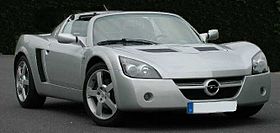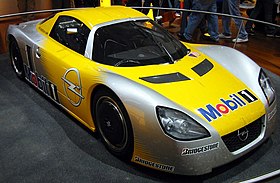Opel Speedster
| Opel Speedster | |
|---|---|
 | |
| Overview | |
| Manufacturer | Lotus |
| Also called | Opel Speedster Turbo (2004–2005) Vauxhall VX220 (United Kingdom) Vauxhall VX220 Turbo (2004–2005) Daewoo Speedster |
| Production | 2000–2005 |
| Assembly | England: Hethel, Norfolk |
| Designer | Niels Loeb and Martin Smith (exterior) Steven Crijns (interior)[1] |
| Body and chassis | |
| Class | Sports car |
| Body style | 2-door roadster |
| Layout | Transverse mid-engine, rear-wheel drive |
| Platform | Lotus Elise Series 2 platform |
| Related | |
| Powertrain | |
| Engine | 2.2 L Ecotec Z22SE I4 2.0 L Z20LET turbo I4 |
| Transmission | 5-speed Getrag F23 manual |
| Dimensions | |
| Wheelbase | 91.7 in (2,329 mm)[3] |
| Length | 149.2 in (3,790 mm)[3] |
| Width | 67.2 in (1,707 mm)[3] |
| Height | 43.8 in (1,113 mm)[3] |
| Kerb weight | Speedster: 870 kg (1,918 lb) Speedster Turbo: 930 kg (2,050 lb) |
| Chronology | |
| Successor | Opel GT (European Union) Vauxhall Monaro VXR (United Kingdom) |
The Opel Speedster also known as the Vauxhall VX220 is a mid-engined, targa-topped, two seat sports car sold by the German automaker Opel, introduced in July 2000.[4] It was built in both RHD and LHD versions, at the Lotus Cars plant in Hethel, Norfolk, England. It was presented at the Geneva Motor Show in March 1999, and went into full production the following year.
It was sold as the Vauxhall VX220 in the United Kingdom and shared much in common with the Lotus Elise, although Opel claimed few parts were interchangeable. In April 2001, Griff Rhys Jones was dismissed by Vauxhall, after an embarrassing advert for the VX220 the previous year, with Vauxhall stating they wanted to move in a different direction.[5] The advert was also voted “Worst of the Year” by an industry magazine.
Design and development



Due to the changes in European crash safety regulations for the 2000MY, Lotus needed to replace the original Elise.
In October 1999, they struck a deal with General Motors in order to have sufficient investment for a new car.[6] As part of the deal, Lotus agreed to develop and produce the Opel Speedster and Vauxhall VX220 on the new Series 2 Elise chassis.[6] The first Speedster concept car was shown at the 1999 Geneva Motor Show.[6]
Whilst the new Elise would use a 1.8 litre Toyota engine, similar to that found in the Toyota Celica, the Speedster was designed to use a 2.2 litre GM Ecotec engine from the Opel Astra.[7] Neither engine had been used in the original Elise, which was fitted with a 1.8 litre Rover K-Series engine.[7]
In order to accommodate the production of the new cars, Lotus expanded its Hethel factory to a capacity of 10,000 cars, with around 3,500 slots allocated to Speedster production. The first Speedster left the factory in Hethel. Production of the Speedster commenced in March 2001.[6]
The Speedster utilizes an aluminium chassis tub that weighs only 72 kg (159 lb). The car also features bodywork made entirely of glass-reinforced plastic (GRP).
The entire car weighs only 875 kg (1,929 lb), which made it 100 kg (220 lb) lighter than the similarly sized Toyota MR2. At launch, the Speedster's all aluminium alloy 2.2 L Z22SE engine produced 145 hp (147 PS; 108 kW), making the Speedster considerably more powerful than the Elise was at launch.
As an answer to calls for a more powerful version of the Speedster, Opel introduced a new two litre turbocharged version of the Ecotec engine, which produced 200 hp (203 PS; 149 kW), but also weighed slightly more, at 930 kg (2,050 lb). Moreover, in 2004, a limited run of sixty track focused Speedsters were produced for the United Kingdom.
The cars, badged Vauxhall VXR220, were equipped with larger brakes, upgraded tyres and lowered suspension, and tuned to produce 220 hp (223 PS; 164 kW). Other features included more performance oriented seats and unique Speedline alloy wheels. The wheels were 16 in at the front and 17 in at the rear, the same as the Elise.
Calypso Red was the only available exterior colour.[8]
Production
The turbo version was able to reach a top speed of 242 km/h (150 mph) and accelerate from 0 to 100 km/h (62 mph) in 4.7 seconds. The car was hailed by the motoring press as a great drivers' car and won several accolades, including Top Gear's Car of the Year in 2003.
The 2.2 NA (naturally aspirated) version was considered the easier drive of the two standard variants, and some journalists recommended that the Opel/Vauxhall car was better value for money than the Lotus (such as Jeremy Clarkson in his DVD of 2003, Shoot Out).
Speedsters were displayed with the Daewoo badge, although only one was built to be used for marketing purposes.
In the end of 2002, following the termination of the license by General Motors for the Ecotec 2.2 NA Speedster and VX220 Engine models (and development of upcoming models of the Speedster and VX220 Turbo), 48 RHD 2.2 NA models have been refused by Daewoo in South Korea, Holden Australia and concessions of Opel Japan, and returned to Lotus, in Hethel.
Some of them have been converted in Turbo models and some were sold under the badge "Lotus VX220" with sometimes confidential commercial editions like the "Cup Edition" and "Le Mans Series". These editions contained a black leather interior, specific stickers and serial floor mats.
Production ended on 22 July 2005, after five years, with no direct successor. It was not until February 2007, when GM Europe adopted the Pontiac Solstice/Saturn Sky into the Opel GT, that GM Europe had a replacement sector product, with no RHD version for the United Kingdom. The final production number of the Speedster was only 7,207.
Opel ECO Speedster
| Opel ECO Speedster | |
|---|---|
 | |
| Overview | |
| Manufacturer | Opel (General Motors) |
| Production | 2002 (Concept car) |
| Body and chassis | |
| Class | Sports car |
| Body style | 2-door coupé |
| Layout | Transverse rear mid-engine, rear-wheel-drive |
| Doors | Gullwing doors |
| Related | Opel GT |
| Powertrain | |
| Engine | 1.3 L CDTI I4[9] |
| Transmission | 5-speed Easytronic semi-automatic |
The Opel ECO Speedster is a concept car made by Opel in 2002. The OPEL ECO Speedster is related to the production Opel Speedster and the Opel GT, and it is a two-door coupe with two seats and gullwing doors without any driving mirrors. It was shown at the 2002 Paris Motor Show.
References
- ^ "Lotus Press Release, Vauxhall Announce Production VX220". Sandsmuseum.com. 19 May 1999.
- ^ "Official Website of ''Lynx electric''". Lynxcars.webtemplet.dk. Archived from the original on 23 September 2010. Retrieved 2 October 2010.
- ^ a b c d e "Opel Speedster 2.2 16v 147 hp - Specs & Performance". ZePerfs. Retrieved 8 December 2015.
- ^ "Opel Speedster – The Essence of Dynamic Driving". GM Media Online. 12 February 2001.
- ^ Roland Gribben (13 April 2001). "Vauxhall gives comedian the boot". telegraph.co.uk. Retrieved 1 December 2015.
- ^ a b c d "Lotus to build the Opel Speedster/Vauxhall VX220". The Auto Channel. 18 October 1999. Retrieved 14 April 2015.
- ^ a b "From The Classifieds: 2001 Vauxhall VX220". motoring.com.au. 17 December 2012. Retrieved 14 April 2015.
- ^ Hales, Mark (24 July 2004). "Assuming the Lotus Position". The Telegraph. Retrieved 24 November 2016.
- ^ "Opel Eco Speedster". Car Design News. Car Design News Inc. Archived from the original on 28 September 2013. Retrieved 25 September 2013.
External links
 Media related to Opel Speedster at Wikimedia Commons
Media related to Opel Speedster at Wikimedia Commons Media related to Vauxhall VX220 at Wikimedia Commons
Media related to Vauxhall VX220 at Wikimedia Commons
